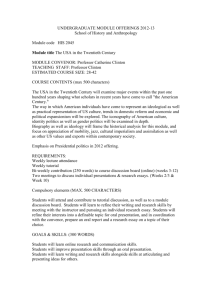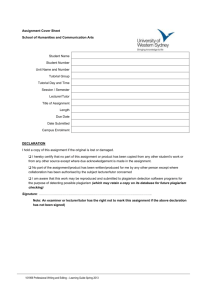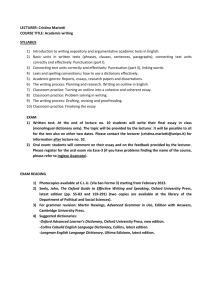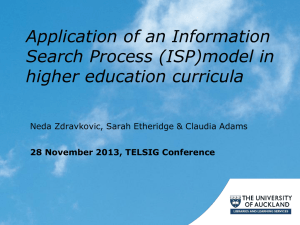COURSE SYLLABUS Course Title : Political Economics Coordinator
advertisement
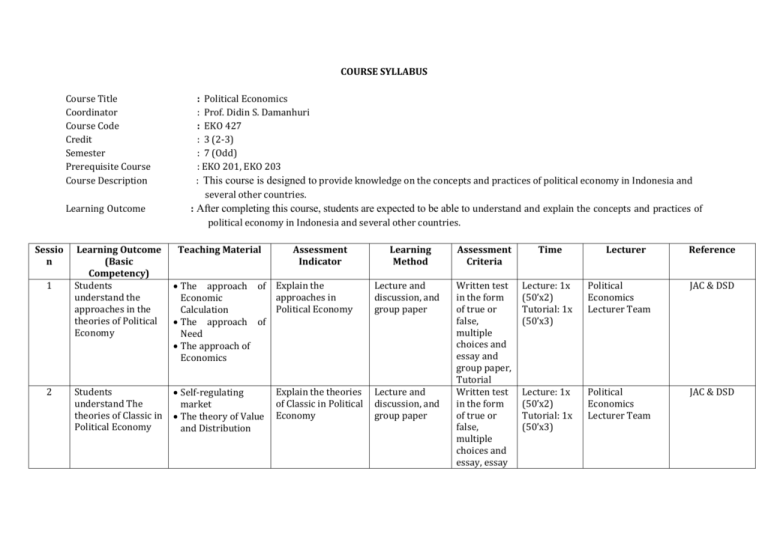
COURSE SYLLABUS Course Title Coordinator Course Code Credit Semester Prerequisite Course Course Description Learning Outcome Sessio n 1 2 Learning Outcome (Basic Competency) Students understand the approaches in the theories of Political Economy Students understand The theories of Classic in Political Economy : Political Economics : Prof. Didin S. Damanhuri : EKO 427 : 3 (2-3) : 7 (Odd) : EKO 201, EKO 203 : This course is designed to provide knowledge on the concepts and practices of political economy in Indonesia and several other countries. : After completing this course, students are expected to be able to understand and explain the concepts and practices of political economy in Indonesia and several other countries. Teaching Material Assessment Indicator Learning Method The approach of Explain the approaches in Economic Political Economy Calculation The approach of Need The approach of Economics Lecture and discussion, and group paper Self-regulating market The theory of Value and Distribution Lecture and discussion, and group paper Explain the theories of Classic in Political Economy Assessment Criteria Time Lecturer Reference Written test in the form of true or false, multiple choices and essay and group paper, Tutorial Written test in the form of true or false, multiple choices and essay, essay Lecture: 1x (50’x2) Tutorial: 1x (50’x3) Political Economics Lecturer Team JAC & DSD Lecture: 1x (50’x2) Tutorial: 1x (50’x3) Political Economics Lecturer Team JAC & DSD Sessio n Learning Outcome (Basic Competency) 3 Students understand the theories of Marxism Political Economy 4 Students understand the theories of Neoclassical Political Economy 5 Students understand the theory of Keynesian Political Economy Teaching Material The theory of Revolution The theory of Social Democracy The theory of States The theory of Imperialism The theory of NeoMarxism The Agendas of Nation The Types of Market Failure: Monopoly, Externalities and Public Goods Assessment Indicator Learning Method Explain the similarities and or differences of the theories of Marxism Political Economy Lecture and discussion, and group paper Explain the theories of Neoclassical Political Economy related to market failure, externalities, and public goods Lecture and discussion, and group paper Critics on self- Explain the concept of government regulating market Nation Intervention intervention in the theory of Keynesian Political Economy Lecture and discussion, and group paper Assessment Criteria and group paper, Tutorial Written test in the form of true or false, multiple choices and essay, essay and group paper, Tutorial Written test in the form of true or false, multiple choices and essay, essay and group paper, Tutorial Written test in the form of true or false, multiple choices and essay, essay and group Time Lecturer Reference Lecture: 1x (50’x2) Tutorial: 1x (50’x3) Political Economics Lecturer Team JAC & DSD Lecture: 1x (50’x2) Tutorial: 1x (50’x3) Political Economics Lecturer Team JAC & DSD Lecture: 1x (50’x2) Tutorial: 1x (50’x3) Political Economics Lecturer Team JAC & DSD Sessio n Learning Outcome (Basic Competency) Teaching Material 6 Students understand the theory of Heterodox Political Economy The theory Dualism The theory Equilibrium Poverty The theory Asian Values The Cycle of Poverty Theory 7 Students understand the theories of Economy-based Political Economy The theory of Public Choice Public Policy Analysis Institutional Body Assessment Indicator of Explain the similarities and or of differences of in several theories of Heterodox Political of Economy Explain the theories of public choice, institutional body, and public policy analysis Learning Method Lecture and discussion, and group paper Lecture and discussion, and group paper Assessment Criteria paper, Tutorial Written test in the form of true or false, multiple choices and essay, essay and group paper, Tutorial Written test in the form of true or false, multiple choices and essay, essay and group paper, Tutorial Time Lecturer Reference Lecture: 1x (50’x2) Tutorial: 1x (50’x3) Political Economics Lecturer Team JAC & DSD Lecture: 1x (50’x2) Tutorial: 1x (50’x3) Political Economics Lecturer Team JAC & DSD Lecture: 1x (50’x2) Tutorial: 1x (50’x3) Political Economics Lecturer Team JAC & DSD MID-TEST/UTS (40%) 8 Students understand the theories of Powerbased Political Economy Corporation Power in Market Capital Owner Power on Labour Union Conditioned Power Explain several theories of Powerbased Political Economy Lecture and discussion, and group paper Written test in the form of true or false, multiple choices and essay, essay and group Sessio n Learning Outcome (Basic Competency) Teaching Material Assessment Indicator Learning Method 9 Students understand the theory of Nationbased Political Economy The Utilitarian Approach The Marxian Approach The Statist Approach Structural History/Transform ation Explain the similarities and or differences of several approaches of Nation-based Political Economy Lecture and discussion, and group paper 10 Students understand the Rent-seeking Economic Activities (RSEA) The definition of Explain the definition, impacts, RSEA The impacts of and solution of RSEA problem RSEA The solution of RSEA Lecture and discussion, and group paper 11 Students understand Proletarization problem The definition of Proletarization The emergence of Proletarization problem Lecture and discussion, and group paper Explain the definition and background of Proletarization problem Assessment Criteria paper, Tutorial Written test in the form of true or false, multiple choices and essay, essay and group paper, Tutorial Written test in the form of true or false, multiple choices and essay, essay and group paper, Tutorial Written test in the form of true or false, multiple choices and essay, essay and group paper, Time Lecturer Reference Lecture: 1x (50’x2) Tutorial: 1x (50’x3) Political Economics Lecturer Team JAC & DSD Lecture: 1x (50’x2) Tutorial: 1x (50’x3) Political Economics Lecturer Team JAC & DSD Lecture: 1x (50’x2) Tutorial: 1x (50’x3) Political Economics Lecturer Team JAC & DSD Sessio n Learning Outcome (Basic Competency) Teaching Material Assessment Indicator Learning Method City State Vs Peripheral State Dependency Problem Solving Explain the dependency problem and its solution Lecture and discussion, and group paper Students understand the concept of Welfare State Welfare State problem in developing countries Welfare State prospect in developing countries Explain the concept of welfare state in developing countries Lecture and discussion, and group paper Students understand the Politic and Economic Model of Japan Lecture and The concept of Explain the politic and economic model discussion, and Politics in Japan group paper The concept of of Japan Economy in Japan 12 Students understand the Dependency Problem 13 14 Assessment Criteria Tutorial Written test in the form of true or false, multiple choices and essay, essay and group paper Written test in the form of true or false, multiple choices and essay, essay and group paper, Tutorial Written test in the form of true or false, multiple choices and essay, essay and group paper, Time Lecturer Reference Lecture: 1x (50’x2) Tutorial: 1x (50’x3) Political Economics Lecturer Team JAC & DSD Lecture: 1x (50’x2) Tutorial: 1x (50’x3) Political Economics Lecturer Team JAC & DSD Lecture: 1x (50’x2) Tutorial: 1x (50’x3) Political Economics Lecturer Team JAC & DSD Sessio n Learning Outcome (Basic Competency) Teaching Material Assessment Indicator Learning Method Assessment Criteria Time Lecturer Tutorial FINAL TEST/UAS (40%) TUTORIAL including ASSIGNMENT (20%) LITERATURE REFERENCE : 1. Caporaso, James A & David P. Levine. The theories of Political economy. Yogyakarta: Pustaka pelajar. 2008. 2. Damanhuri , Didin S. Ekonomi-Politik dan Pembangunan . Bogor: IPB Press. 2010. LECTURER TEAM : Prof. Dr. Didin Damanhuri, Dr. M. Findi Alexandi LEARNING METHOD : Lecture, Discussion and Group Paper ASSIGNMENT DESIGN : Paper assignment is given one time in groups, each group consists of 5-6 students. (1) Paper is made with topic related to the material and micro problems given for one semester ASSESSMENT FORMAT : Exam and Assignment Mid-test (UTS) Final Test (UAS) Tutorial & Assignment (Paper) : 40 % : 40 % : 20 % Reference
